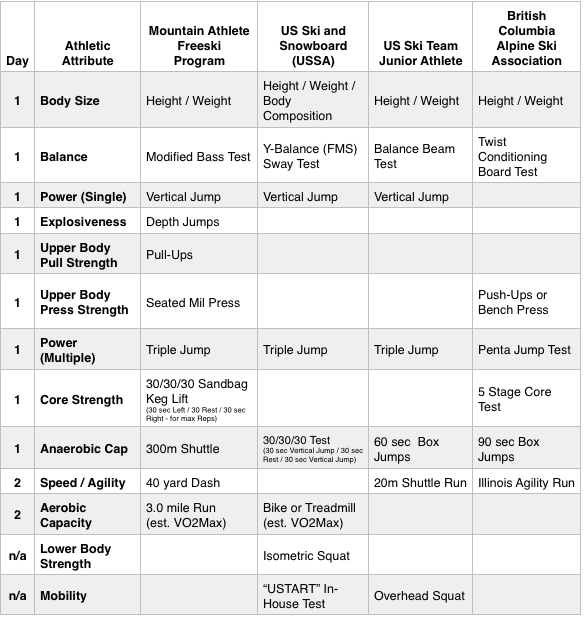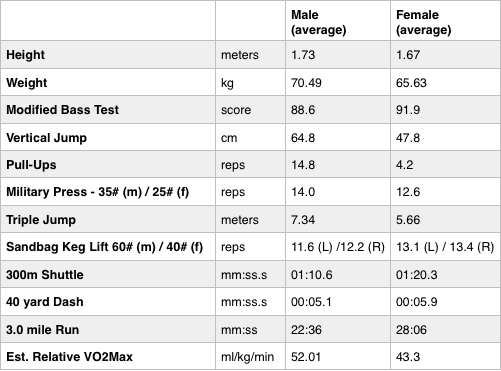By Adam Scott, MS, CSCS
This article was first published in June 2015
June 15th marked the beginning of our summer Freeski Training Program. This year’s training incorporates new methodologies. Training will begin with a focus on athlete endurance and what we are calling, “chassis integrity” – a combination of core and lower body strength and stability. Over the course of the program, we will progress into more intense sprint and plyometric training.
In preparation for this new plan, we developed an assessment battery to develop an athletic baseline for our ski athletes.
Background
To help build our assessment battery we looked at what other prominent ski programs were using. We even took a trip to the US Ski and Snowboard Association (USSA) Center of Excellence in Park City, Utah.
Our skiers face a number of athletic challenges when competing in their events. We took these athletic demands and divided them into categories we could assess: (1) Power (single event), (2) power (multiple event), (3) explosiveness, (4) upper body strength, (4) lower body (5) strength, (6) core strength, (7) aerobic fitness, (8) speed/agility, (9) anaerobic fitness, and (balance).
You may notice that we did not identify mobility as one of these attributes. This was not an oversight – we definitely recognize the importance of mobility. However, because we could not find a meaningful, performance based way to assess mobility in our athletes we decided to leave it off the assessment for the time being.
The USSA had similar complaints about the mobility assessments they typically see, and have devised an in-house assessment they call the “USTART.”
Although we did not develop our own mobility assessment we did utilize a few of our own assessments for other athletic attributes. For balance we took the Modified Bass Balance Test, a test usually used for clinical populations, and adapted it to our athletes by expanding the distance between test points from 15″ and 30″ to 25″ and 40″.
We also used the seated military press assessment we designed for our Fire/Rescue Athletes to test our athlete’s upper body pressing power. Lastly, without a good core strength test available, we elected to use our own 30/30/30 Sandbag Keg Lift assessment. This test assesses an athletes core strength through rotational, isometric, and eccentric movements.
Here is how our Assessment Battery compared to some of the others we looked at. The events are listed in the order that we completed them:
Data
We had 20 total athletes participate in the initial assessment (8 male and 12 female). Of the 20 who participated 14 completed all 10 tests. For the sake of time we divided the test into two days. The first day consisted of gym based events (height/weight, vertical jump, depth jump, pull-ups, military press, core strength test, balance test, and anaerobic test). The second day took place at a local track (40 yard dash, 3 mile run).
Here is how our athletes performed on the events:
Results
Aerobic Capacity: Needs work.
For the most part our athletes scored relatively well on their aerobic test when compared to the general population. 4 out of 6 males who completed the 3 mile assessment were in the 90th percentile and the overall average was the 85th. The females also scored well against the general population. Their average percentile score was the 70th.
However, our numbers were far below what we saw from athletes at the USSA center – where males scored in the low 60s to high 70s (ml/kg/min) and females were in the mid 50s to low 70s (ml/kg/min)
Anaerobic Performance: Average.
On the 300m Shuttle (our test of anaerobic performance) our male athletes averaged 70 seconds and our females were close to the 80 seconds. This puts both groups in the “average” category for athletes their age.
For adult males “above average” is considered 65-59.1 seconds. With excellent scores being in the low 50 second range.
Vertical Jump: Close, but room to improve.
Our male athletes ranged from 59cm to 73cm. These numbers were fairly close to the numbers we received during our visit to the USSA. Although they use a slightly different testing criteria (which gives them slightly lower numbers), the USSA looks for jumps heights of between 60-75cm from their male athletes.
Our female athletes ranged from 40cm to 55cm. This put them on the lower end of athletes from the USSA. Again, using a slightly more stringent criteria, the USSA female athletes score between 50-60cm on average.
Triple Jump: Above Average, but not breaking any records.
The standing triple jump is a great way to assess an athlete’s power and explosiveness. It requires an athlete to perform three back-to-back broad jumps. Thus it incorporates an athlete’s ability to produce power, balance, load, and explode – very important for skiers.
While visiting the USSA we saw their top 5 scores on this event for both males and females.
For males the top 5 distance all fell between 9.76m and 9.93m. Our best male was 7.90m and the group averaged 7.34. This put our male athletes a full 2 meters behind the best at the USSA.
For females at the USSA the top five distances fell between 8.02m and 8.52m. Our best female was 5.97m and the group averaged 5.66m, almost 2.5 meters behind the record holders.
Discussion
We developed this test battery with three major goals in mind: (1) To help provide us with baseline performance numbers on our athletes, (2) To help inform our training program as we plan for each cycle and (3) To help us find ways to compare our athletes to other athletes in the sport.
The test battery was extremely effective in providing us with initial measures on our athletes. As we progress through our training plan we will continue to revisit the assessments to ensure our athletes are building the necessary athletic skills. The only measure we might add is an assessment of lower body strength. Since we don’t have the ability to do an isometric squat on force plates like they do at the USSA we will most likely look at other simpler assessments like Front or Back Squat.
Furthermore, the baseline data from the test battery allowed us to see where our athletes needed the most training. We clearly identified a need for aerobic conditioning, anaerobic performance, power and explosiveness. Using this information we have been able to refine and develop our programming cycles even more efficiently.
As for allowing us to compare our athletes to others in the sport, we still need to see more standardized testing and procedures. This is especially true for measures of balance, core strength, upper body strength, lower body strength, and anaerobic performance.
Questions, Feedback? Email coach@mtntactical.com
Comments? Use the comment section below
You Might Also Like MTI’s 30 Minutes Per Day Dryland Ski Training Plan


